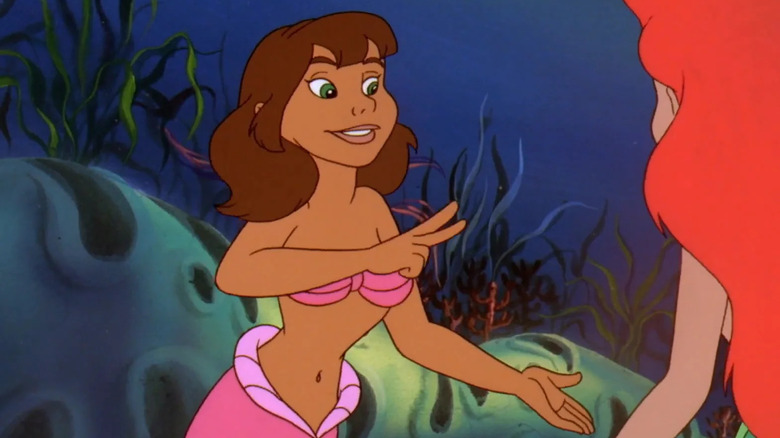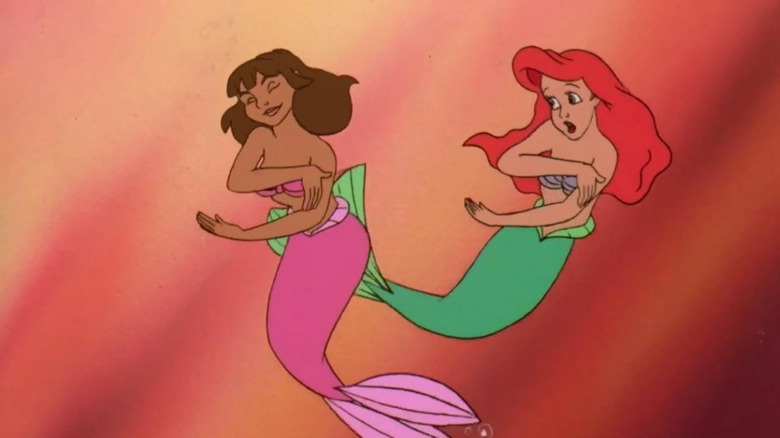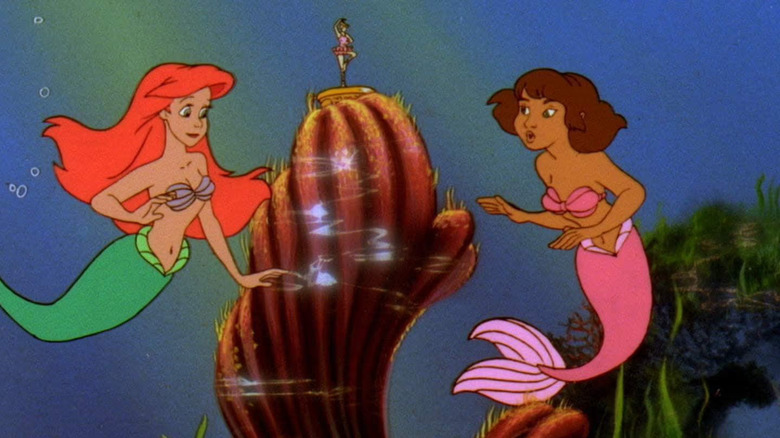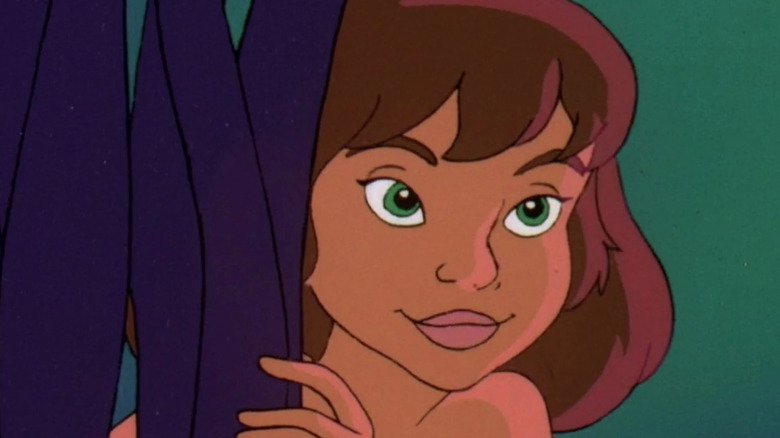Disney's The Little Mermaid Series Has Always Been A Showcase For Diversity
Disney's live-action reimaginings of beloved classics have made it their mission to update the story's more outdated ideals and expand the canvas of who is being represented on screen and how. Dating back to their first feature in 1937, "Snow White and the Seven Dwarfs," the characters in Disney's animated films are mostly white, always straight, and follow the same damsel in distress narratives. The movies reflected the more conservative values of the time.
But today, as society continues to evolve, these new takes on classic fairy tales take many steps to diversify. The remakes give the princesses more chutzpah, allowing them to save themselves without needing the prince. "Beauty in the Beast" made LeFou openly gay (although it is a blink-and-you'll-miss-it moment). "The Little Mermaid" made waves when Halle Bailey, a Black actress, was cast as the curious redhead Ariel. The live-action "Little Mermaid" improves on the original through its multiracial casting, creating a vibrant environment on both sea and shore. Each of Ariel's sisters is a different ethnicity that aligns with one of the seven seas they represent. Ariel's father is played by Spanish actor Javier Bardem, and Noma Dumezweni plays Prince Eric's mother. The island setting has a more Caribbean flavor, which feels much more fitting and fun compared to the original animated film's generic European location.
But Disney's effort to showcase more diverse characters isn't entirely new, even in "The Little Mermaid" world. In the 1992 animated series "The Little Mermaid," there's a Latina mermaid named Gabriella, who is also Deaf. Disability is frequently overlooked under the diversity umbrella in media, making Disney's early inclusivity of this character particularly heartwarming.
Gabriella's touching backstory
Gabriella appeared twice in the animated series "The Little Mermaid" as Ariel's close friend. She has bright green eyes, a pink tail, and a brunette bob with blunt bangs. She communicates with American Sign Language translated by her cute octopus friend, Ollie, so that hearing viewers or those who do not know ASL can understand Gabriella's thoughts and feelings. Gabriella is also able to read lips.
According to the Los Angeles Times, Disney already had plans to incorporate a Deaf character in the series, but they modeled her on Gabriella Angelina Bommino, a 2-year-old "Little Mermaid" superfan who sadly passed away from leukemia. Her inclusion in the animated series was a beautiful way for her parents to see what she might have looked like as a teenager. This touching backstory makes Gabriella's presence in the series even more meaningful.
What episodes does Gabriella appear in?
In "Wish Upon a Starfish," Gabriella and Ariel bond over their shared dreams of expressing themselves through the unattainable skills of singing and dancing. They travel to the Magical Starfish to fulfill their dreams, but he actually has no powers. Through their journey, Gabriella comes to appreciate the beauty of sign language as her own unique form of singing, while Ariel realizes that she can use her tail to make exquisite movements. In a sweet scene, Ariel sings while Gabriella interprets with American Sign Language, lovingly describing her hand movements as "a song you can see with your eyes." They discover that their inner beauty and individuality is what truly makes them special.
In the season 3 episode "Ariel's Treasures," Gabriella comes to hang out in Ariel's grotto and marvel at her whozits and whatzits galore. She bravely helps her friend after Ursula puts a spell on her collection to attack the merpeople of Atlantica. Although Ariel has to destroy her collection, she comes to understand that what matters more than objects are her true friends like Gabriella. Although Gabriella briefly appears in the "The Little Mermaid" series, she leaves a lasting impression on viewers as a kindhearted friend who is just as inquisitive and adventurous as Ariel is.
The impact of a Deaf mermaid
We constantly hear that "representation matters," but it really does. Although pearl-clutching conservative viewers may disagree, showcasing differences in race, disability, gender expression, and yes, even sexuality is vital in children's media. It allows young viewers to develop a broader perspective of the world and learn empathy. The animators of "The Little Mermaid" series could have easily made Ariel's friend another white, able-bodied mermaid, but they didn't. This choice greatly impacted children watching the show — including myself. Although I am not Deaf, I am hard of hearing. Growing up, I was often mocked for my brightly-colored hearing aids, making me believe that my disability was something to hide. I hated being different and I rarely shared my hearing loss with others.
But watching Gabriella on Disney Channel reruns helped me feel less ashamed. The series frames Gabriella's disability as something beautiful. Her use of sign language becomes a graceful ballet of expression and joy. It was empowering to see Gabriella's strength and compassion co-exist alongside her Deafness. And she's a beautiful mermaid??? For a girl who would spend hours pretending to be a mermaid in the pool, seeing this magical creature with a similar disability was very comforting. Ariel embraces her friend's Deafness as a natural and wonderful part of who she is. Despite their differences, Gabriella and Ariel share all the typical joys of friendship: they laugh, confide secrets, and play together.
Gabriella marked an incredible stride in Disney's ongoing journey toward diversity. I'd love to see a Disney princess with a disability someday! For young viewers, seeing a character on screen who is just like you, after you've been made to feel uncomfortable about your identity, can make you feel so much less alone and proud of who you are.



